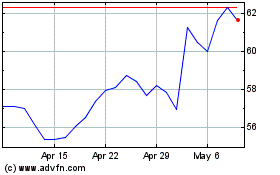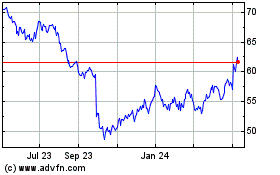By Micah Maidenberg and Jaewon Kang
Cereal makers, under increasing competitive pressure, are
struggling to improve sales of puffed rice, wheat flakes and oat
clusters that were once a standard part of Americans' morning
routines.
Fast-food chains are beckoning customers with new breakfast
products and bacon-laden promotions. More people say they are
eating less sugar and more protein, or forgoing breakfast
altogether. Snack bars for on-the-go consumers are ubiquitous.
"There's a lot more competition for breakfast than there ever
has been," General Mills Inc. Chief Executive Jeff Harmening said
in a recent interview. The maker of Cheerios and Wheaties has
reported flat cereal sales in the U.S. in its past three fiscal
years--coming in at about $2.3 billion annually.
General Mills and its peers have tried before to revive cereal's
fortunes. They doubled down on sugary versions and pitched cereal
for dinner or as a late-night snack. Now manufacturers say they are
stepping up spending by retooling marketing campaigns, ramping up
product investments and developing new flavors to try to keep
shoppers engaged.
Cereal's trials reflect broader challenges food makers face as
they try to revitalize products that have been staples in American
kitchens for decades to match changing tastes and heightened
competition. Condensed soup sales at Campbell Soup Co. have fallen
for years. Kraft Heinz Co.'s meats and cheese products have been
hurt by store brands from retailers and organic alternatives.
Likewise, cereal makers must demonstrate that they can draw
higher demand as retailers review how they stock the shelves at the
center of their stores. Cereal is a mainstay of those center
aisles, where retailers typically place everything from pasta to
sugar. Grocery stores historically took much of their profit from
this area, and sales there have been hit hard by trends toward
online shopping and fresher foods.
"Grocers are forced to be a little bit more selective as trips
to center stores go down," said Hunter Williams, partner at
consulting firm Oliver Wyman.
Retailers lowered the number of major cereal brands available in
stores in each of the last three years, according to Nielsen data
analyzed by Wells Fargo food business analyst John Baumgartner.
U.S. consumers purchased about $8.49 billion of cold cereal last
year, according to market-research firm IRI, down 6% from five
years earlier. Sales of hot cereals, a smaller category, grew 1%
over the same period. Market-research firm Mintel expects cereal
sales to fall 5% between last year and 2023.
Food makers, however, have said their investment and marketing
plans can lift cereal sales again.
Post Holdings Inc. said earlier this month that North American
sales of its cereal brands were up 2% in the first three quarters
of its current fiscal year, helped by demand for Honey Bunches of
Oats and store-brand cereals it makes for retailers.
Kellogg Co., which makes Raisin Bran, Special K and Frosted
Flakes, saw sales of its cereal brands drop 5% in the first six
months of this year compared with that period in 2018.
Chief Executive Steve Cahillane said in an interview that the
company had pulled back on promotions while transitioning to a more
standard set of box sizes, a move meant to simplify factory
operations and help customers find Kellogg cereals on store
shelves.
"It is a category in the United States that is showing a 1%
decline," Mr. Cahillane said of cereal. "That can be turned
around."
Kellogg is also trying to lift sales by developing new cereals,
including a brand focused on gut health, and by adding new flavors
of older brands such as Wild Berry Froot Loops and
strawberry-flavored Rice Krispies. Those are the first flavors
Kellogg has added to those well-known brands in at least a
decade.
General Mills is also aiming to jump-start U.S. cereal sales
with more marketing and new products. It recently hired rapper
Travis Scott to design boxes for its Reese's Puffs cereal. Boxes
from the limited run are being sold as collectors' items on
eBay.
Its newer products include a cereal that lists almonds as its
first ingredient, meant to appeal to shoppers looking for protein,
and blueberry-flavored Cheerios.
General Mills told investors last month that U.S. demographic
trends are also working in cereal's favor. A growing population of
adults aged 55 years and older and rising numbers children in the
U.S. should bolster cereal demand, executives said. Per capita
consumption of cereal is relatively high among these two groups,
according to the company.
The Census Bureau expects there to be 21 million children
younger than five in the U.S. by 2030, up 2.6% over a decade. The
agency also forecasts a slightly older group, people aged 65 and
over, to rise 31% to 73 million people by 2030.
That doesn't solve the broader problem of getting people to eat
cereal instead of breakfast bars and burritos.
"It's not that people don't eat breakfast. It's more that they
don't eat it the way they used to," said Tory Gundelach, a former
Kroger Co. executive and analyst at Kantar Consulting.
Write to Micah Maidenberg at micah.maidenberg@wsj.com and Jaewon
Kang at jaewon.kang@wsj.com
(END) Dow Jones Newswires
August 20, 2019 05:44 ET (09:44 GMT)
Copyright (c) 2019 Dow Jones & Company, Inc.
Kellanova (NYSE:K)
Historical Stock Chart
From Mar 2024 to Apr 2024

Kellanova (NYSE:K)
Historical Stock Chart
From Apr 2023 to Apr 2024
